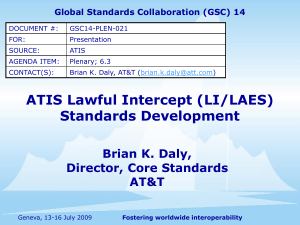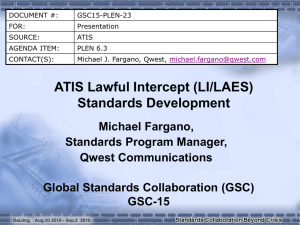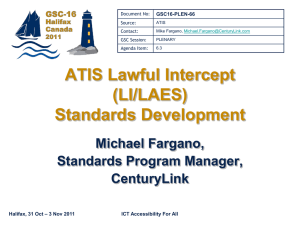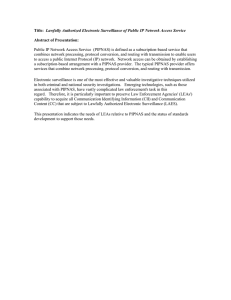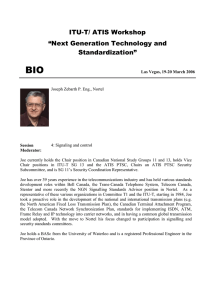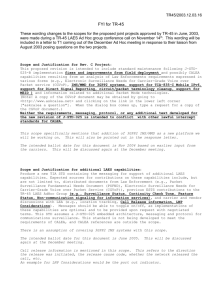DOCUMENT #: GSC13-PLEN-36 FOR: Presentation
advertisement
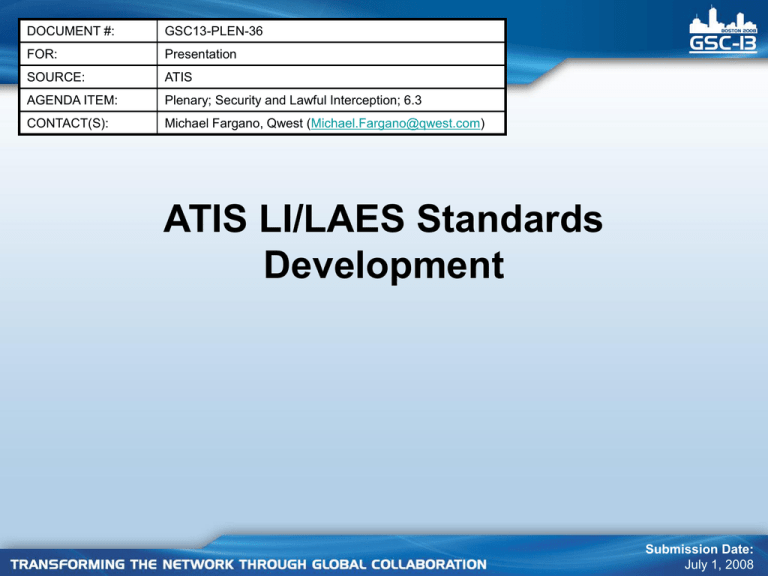
DOCUMENT #: GSC13-PLEN-36 FOR: Presentation SOURCE: ATIS AGENDA ITEM: Plenary; Security and Lawful Interception; 6.3 CONTACT(S): Michael Fargano, Qwest (Michael.Fargano@qwest.com) ATIS LI/LAES Standards Development Submission Date: July 1, 2008 Highlight of Current Activities (1) Wireline VoIP and Broadband Focus -- PTSC-LAES Subcommittee • Currently focusing on: – Additions/changes to Lawfully Authorized Electronic Services (LAES) standards for: • VoIP • Internet Access and Services (IAS, Broadband) • Advanced VoIP Conferencing Services • Next Generation Networks – Implementation Guidelines for LAES Public IP Network Access Services • Recently completed work: – Data Buffering (Short Term Storage) in an IAS LAES Environment – Wireline Service Provider Job Aid for VoIP and IAS LAES Standards 2 Highlight of Current Activities (2) Wireless/GSM-Evolved Focus – WTSC-LI Subcommittee • Currently focusing on: – Standards for Lawful Intercept (LI) for Push-to-Talk over Cellular (PoC) – Advanced VoIP Conferencing Services – Canadian Specific Location Update Requirements for LAES – Delta documents to 3GPP LI Specifications to support specific USA/Canadian Requirements • Recently completed work: – LI for IMS-based VoIP 3 Strategic Direction • Work within legal and regulatory framework (per USA CALEA law and related FCC regulations, and Canadian regulations) – e.g., USA “Safe-Harbor” provision • Work proactively to support law enforcement’s needs (per reasonable changes and direction) • Work in response to FCC regulatory mandates • Focus on regional needs of LI/LAES (North America) • Coordinate/collaborate with other organizations where appropriate (e.g., TIA) 4 Challenges • Working at the nexus where law, regulation, technology, and standards come together • Delivering standards to satisfy aggressive regulatory mandate target dates such that reliable implementations can be deployed (per target dates) • Determining what is “reasonable” to proactively support law enforcement’s needs (while not crossing the line of interpreting law or regulation) • Change management of LI/LAES standards, e.g.: – Separating implementation guidelines from necessary changes to the standards – FCC petition process 5 Next Steps/Actions • Complete currently defined work program • Continue appropriate changes to current standards suite • Respond (at appropriate time) to the expectation of more information from FCC regarding J-STD-025B and possibly other NGN related LI/LAES standards • Continue with cross-organizational coordination and collaboration 6 Proposed Resolution • N/A 7 Supplemental Slides 8 General Drivers for LI/LAES Drivers: • Stimulated by passage of the U.S. 1994 Communications Assistance for Law Enforcement Act (CALEA) • FCC Mandates • Law Enforcement and National Security needs • “Safe Harbor” – Something (as a statutory or regulatory provision) that provides protection (as from a penalty or liability). From Merriam-Webster's Dictionary of Law © 2001. 9 PTSC Mission/Scope • Packet Technologies and Systems Committee (PTSC) – http://www.atis.org/0191/index.asp – Mission: PTSC develops and recommends standards and technical reports related to services, architectures, and signaling, in addition to related subjects under consideration in other North American and international standards bodies. – Scope: The Packet Technologies and Systems Committee: • Coordinates and develops standards and technical reports relevant to telecommunications networks in the U.S. • Reviews and prepares contributions on such matters for submission to U.S. ITU-T and U.S. ITU-R Study Groups or other standards organizations. • Reviews for acceptability or per contra the positions of other countries in related standards development and takes or recommends appropriate actions. 10 PTSC-LAES Mission/Scope • PTSC Lawfully Authorized Electronic Surveillance Subcommittee (PTSC LAES) – Mission: The PTSC LAES Subcommittee develops and recommends standards, technical requirements and technical reports related to Lawfully Authorized Electronic Surveillance (LAES) of packet-mode technologies in a wireline environment. – Scope: Coordinates and develops standards, technical requirements, technical reports and other documents relevant to LAES of packet-mode technology in telecommunications networks in the U.S., taking advantage of standards development progress in other standards organizations, e.g., IETF, WTSC and ETSI. In as much as the development of standards may be evolved or influenced by several ATIS technical committees/forums, PTSC and the PTSC LAES Subcommittee will maintain liaisons with appropriate ATIS committees/forums, as well as with standards-setting bodies, external to ATIS and will adopt other SDO standards as appropriate. 11 WTSC Mission/Scope • Wireless Technologies and Systems Committee (WTSC) – http://www.atis.org/0160/index.asp – Mission: WTSC develops and recommends standards and technical reports related to wireless and/or mobile services and systems, including service descriptions and wireless technologies. WTSC develops and recommends positions on related subjects under consideration in other North American, regional and international standards bodies. – Scope: WTSC coordinates and develops standards and technical reports primarily relevant to wireless/mobile telecommunications networks in the U.S. and reviews and prepares contributions on such matters for submission to the appropriate U.S. preparatory body for consideration as ITU contributions or for submission to other domestic and regional standards organizations. WTSC will maintain liaison with other ATIS Committees as well as external fora as appropriate. WTSC will coordinate closely with other standards developing organizations (e.g., ITU-R, TIA, IEEE, ETSI) on wireless issues to ensure that the work programs are complementary. 12 WTSC-LI Mission/Scope • WTSC Lawful Intercept Subcommittee (WTSC LI) – Mission: WTSC-LI develops, maintains, amends, and enhances American National Standards and other WTSC deliverables related to lawful intercept within the GSM family (GSM/EGPRS/UMTS). This work may be done within WTSC-LI or may be done in close cooperation with other U.S., regional, and international standards and specifications groups to ensure that respective standards and specifications for the GSM family meet North American regulatory and commercial requirements. – Scope: WTSC-LI provides the following functions and capabilities: • Formulate positions in support of WTSC objectives. • Coordinates activities relevant to U.S., regional, and international standards and specifications activities including: • Preparation, review and presentation of contributions as proposed US positions for submission to international standards bodies such as ITU-T; • Establish appropriate mechanisms and coordinate contributions and positions that support WTSC objectives with other relevant committees and organizations (e.g., other US, regional, and international standards and specifications fora). • Evaluate proposals for lawful intercept capabilities within the GSM family. • Transpose 3GPP lawful intercept deliverables into WTSC deliverables. • Develop and coordinate appropriate inputs regarding lawful intercept aspects that impact or are impacted by IMT-2000 services. 13 ATIS LAES Standards • • • • • • • • • • WTSC: Lawfully Authorized Electronic Surveillance (LAES) Addendum 1 - Addition of Mobile Equipment Identifier (MEID); (J-STD-025-B-1, September 2006) WTSC: Lawfully Authorized Electronic Surveillance (LAES) - Addendum 2 - Support for Carrier Identity; (J-STD-025-B-2, April 2007) WTSC: UMTS Handover Interface for Lawful Interception; (T1.724-2004 , March 2004) WTSC: Lawfully Authorized Electronic Surveillance (LAES) for 3GPP IMS-based VoIP and other Multimedia Services; (ATIS-0700005, May 2007) PTSC: LAES for Voice Over Packet Technologies in Wireline Telecommunication, (ATIS-1000678.2006) PTSC: Supplement to ATIS-1000678.a.2007X - LAES for Voice Over Packet Technologies in Wireline Telecommunication; (ATIS-1000678.a.2007) PTSC: Data Buffering (Short Term Storage) in an Internet Access and Services LAES Environment; (ATIS-1000021.2007) PTSC: Lawfully Authorized Electronic Surveillance (LAES) for Internet Access and Services; (ATIS-1000013.2007) PTSC: Wireline Service Provider Job Aid for VoIP and IAS LAES Standards; (ATIS 1000022.2007) Link to ATIS Document Store: https://www.atis.org/docstore/default.aspx 14 PTSC LAES Issues • • • • • • • • • • PTSC Issue S0001: Create T1.678 Version 2, April 2006 PTSC Issue S0002: LAES for Public IP Network Access Services, March 2007 PTSC Issue S0022: LAES of NGNs, 2nd Qtr 2008 PTSC Issue S0035: LAES Guidelines/Provider Job Aide for LAES Standards, October 2007 PTSC Issue S0037: Support for LAES of Advanced VoP Conferencing, 3rd Qtr 2008 PTSC Issue S0047: Create a Supplement to ATIS-1000678-2006, Lawfully Authorized Electronic Surveillance for Voice Over Packet Technologies in Wireline Telecommunications Networks, May 2007 PTSC Issue S0054: Update ATIS-1000013.2007 – LAES for Internet Access and Services, 3rd Qtr 2008 PTSC Issue S0056: Supplement B for ATIS-1000678.2006, LAES for VoIP, 3rd Qtr 2008 PTSC Issue S0057: Implementation Guidelines for ATIS-1000013.2007, 4th Qtr 2008 Link to Issue pages: http://www.atis.org/0191/issues.asp 15 WTSC LI Issues • • • • • • WTSC Issue P0009: IMS Based POC (Push-to-talk Over Cellular) LAES Capabilities – Work targeted for completion in late 2008 WTSC Issue P0015: LAES for Server-Based VoIP Conferencing – Work targeted for completion in late 2008 WTSC Issue P0020: Supplement to ATIS-0700005.LAES for 3GPP IMS-based VoIP and other Multimedia Services – Work targeted for completion in late 2008 WTSC Issue P0021: Canadian-specific location update requirements for LAES – Work targeted for completion in late 2008 WTSC Issue P0022: North American changes to 3GPP Lawfully Authorized Electronic Surveillance Standards – Work targeted for completion in late 2009 Link to Issue pages: http://www.atis.org/0160/issues.asp 16

